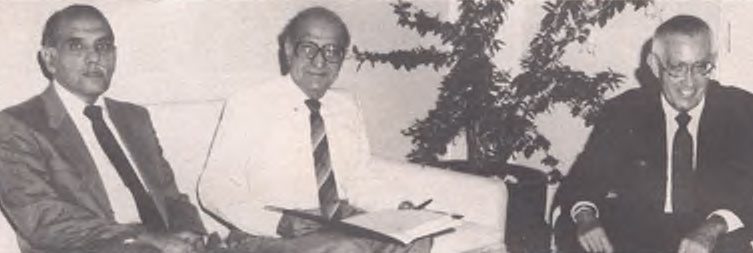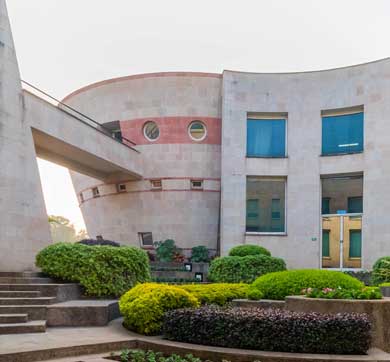May 2023 | 3222 words | 12-minute read
If any sport were to typify the journey of Tata Consultancy Services (TCS), it would be the marathon. Performing well in such a sport requires intensity, strategy, energy, and teamwork; and above all, sheer will. That TCS is now the title sponsor of several major marathons around the world is fitting.
TCS completed financial year (FY) 2022 with $25.7 billion in revenues, accounting for roughly over 11% of the Indian information technology (IT) industry’s estimated revenues for the year. Over 600,000 consultants from 152 nationalities work there, making it the single largest private sector employer in India: more than 35% of the workforce being women. The company is currently the second most valuable IT services brand in the world, according to Brand Finance, and for several years, has been among the top three companies with the highest market capitalisation in India.
The journey started more than 50 years ago at a time when computing in India was limited to government and academic institutions. Tata Sons Chairman N Chandrasekaran, the former CEO of TCS, puts it in perspective: “It is taken for granted now, but if we rewind to 1968, the concept of computing itself was brand new. India had just a handful of computers and everyone was talking about hardware manufacturing. To grasp the potential for a strong services-led economic future through IT services required several leaps of imagination.”
The Beginning
In the early 1960s, the then group chairman JRD Tata, who was deeply interested in computers, approved the creation of a common data processing division for group companies such as Tata Steel and Tata Motors. By 1966, this division, formally named Tata Computer Centre, was doing data processing and share registry work for several customers.
In 1968, four new entities were created as part of a group rejig: Tata Consulting Engineers, Tata Economic Consulting Services, Tata Financial Services and TCS. Tata Computer Centre was integrated into TCS. Work expanded into building inter-bank reconciliation systems, accounting, billing and other software, and extended beyond Tata companies. [see timeline]
"It’s taken for granted now, but if we rewind to 1968, the concept of computing itself was brand new. India had just a handful of computers and everyone was talking about hardware manufacturing. To grasp the potential for a strong services-led economic future through IT services required several leaps of imagination." - Tata group chairman N Chandrasekaran
To strengthen the fledgeling company’s leadership, Mr Tata brought in Faqir Chand Kohli, then the chief of load despatch for Mumbai at Tata Electric (now Tata Power), as TCS’ first general manager — a post specially created for him. Mr Kohli’s appointment would energise TCS and provide it the needed focus; by 1972, he had given the new company a new vision.
He was aware of the impact that IT would have on the nation. In a 1975 speech, he said, “We missed the Industrial Revolution for reasons beyond our control. Today, there is a new revolution — a revolution in information technology. If we miss this opportunity, those who follow us will not forgive us.”
Mr Kohli would lead TCS well into the 1990s and earn the sobriquet ‘Father of the IT Industry’ from his peers.
The Onsite-Offshore Model
Foreign exchange regulations in the 1970s meant that TCS, over a period of five years, had to earn foreign exchange twice the value of the machines it imported. To fulfil this commitment, the company had to look at markets outside India. To add to this, misconceptions that computers would steal human jobs resulted in low adoption of technology by government and business. A combination of such reasons made the domestic IT market insufficient for TCS to hone its expertise and grow, and the then leadership saw merit — despite the challenges — in pursuing business overseas.
“We missed the Industrial Revolution for reasons beyond our control. Today, there is a new revolution — a revolution in information technology. If we miss this opportunity, those who follow us will not forgive us.” - F C Kohli
A significant partner at this time was Burroughs Computers for whom TCS offered sales and services in India and wrote code for its computers globally. In 1972, its engineers based out of Detroit in the US sent down the source code of a hospital information system to Mumbai to be migrated to a higher version of Burroughs’ COBOL. Instead of migrating the programs one by one, TCS developed a set of convertors and filters that converted the source code, despite not having a Burroughs computer. The project earned it $24,000. It was the first recorded instance of an offshore project and possibly the beginning of the Indian IT services industry.
Two years later, TCS built a financial accounting package for two building societies in the UK on behalf of Burroughs. This was the first execution of a project that involved the full software development lifecycle.
By 1976, TCS’s exports had crossed $1 million.
Going West
In 1978, TCS parted ways with Burroughs and pivoted as an independent IT services entity. It now needed to start from scratch, invest in its own sales and marketing organisation, and build its own destiny.

At a time when India was an unknown entity in the west-dominated IT world, it set up its first overseas sales office in New York. Its first win here was a three-year contract with the Institutional Group Information Corporation (IGIC). The contract involved migration from IGIC’s Burroughs computers to an IBM system. This was a pivotal project where the onsite-offshore model was fully leveraged, and a 24-hour service delivery cycle was introduced. The global footprint was a small but certain step from which TCS — and the industry — would only grow.
In the next few years, TCS won critical projects that would help establish the Indian IT services industry as a serious contender for complex technology projects globally. In 1983, it won an offshore project with the Swiss National Bank. The following year saw the company set up the IBM 3090 Mainframe in Chennai that opened up large IBM Mainframe opportunities. Later, in 1989, it competed against some of the best consulting firms in the world to win the $10 million Swiss Securities Clearing Corporation project to create the world’s first real-time domestic and cross border securities clearing and settlement system. This project remains a benchmark till today. The reputation earned by TCS would also help it win India’s National Stock Exchange project a few years later, the first of many that transformed India’s financial institutes.
Y2K and beyond
In the 1990s, many global corporations were worried about the impact the year 2000 would have on their decades-old systems, which were based on a two-digit year nomenclature. This needed a rapid and scaled-up rectification. Applying characteristic innovation and rigor, TCS helped resolve the Y2K bug by setting up a ‘factory-mode’ operation at its Chennai centres. The automation tools developed in-house, and the ‘factory’ process enabled millions of lines of code to be rectified, in time and with accuracy.

The then leadership was quite clear that this one-time rectification of systems would help TCS scale its capabilities but not be sustainable. It helped, though, that TCS was able to understand its clients’ systems from inside out and use this knowledge to help transform their IT operations.
By this time, the Indian ecosystem had also changed; economic liberalisation in 1991 had led to many reforms that encouraged growth of IT exports, an easier taxation and foreign exchange regime, and private and public investment in technical education, among other things.
Expansion and growth
The pioneering spirit that has characterised TCS from its founding days was also evident in the first few years of the new millennium.
The eBusiness division, spearheaded by Mr Chandrasekaran, served as the main starting point in a journey that would, one day, enable TCS to take leadership in a digital era.
In 2000, the company set up a new business division that focused on the opportunities that emerged with the mainstreaming of the Internet and the impact on enterprise IT systems. The eBusiness division, spearheaded by Mr Chandrasekaran, scaled to $500 million within five years and served as the main starting point in a journey that would, one day, enable TCS to take leadership in a digital era.
In 2001, TCS became the first Indian IT company to set up development centres in Hungary, followed by Uruguay and China the next year, which led to the evolution of the Global Network Delivery Model™ (GNDM), a first for any Indian IT services company. Through GNDM™, TCS was able to offer its global customers a uniform expectation of services through its quality systems, process discipline, 24x7 availability and the best talent globally. In a few years, the model would expand to include centres in Latin America, China, Eastern Europe, and North America, besides, of course, India.
In 2003, TCS became the first Indian IT services company to cross $1 billion in revenues. It was also the year in which the company announced the vision of ‘Global Top Ten by 2010’, adding impetus and energy. It followed this up by going public the next year, under the leadership of then CEO S Ramadorai. The highly anticipated IPO did not disappoint; the company became the third-most valued in India immediately on listing and has remained near the top ever since.
This period also saw several big-ticket acquisitions that would help TCS widen its base in terms of geographical reach, acquisition of capability and intellectual property, and access to key markets. In 2002, TCS moved into Latin America, getting a headstart in the strategically important region. By 2007 — when other Indian IT services companies began to foray into the geography — TCS had already expanded to eight Latin American countries, giving itself an edge.
By the early 2020s, the company was among the three largest employers in Latin America and crossed $1.1 billion in revenues there.
As then COO Mr Chandrasekaran said, “The importance of Latin America is three-dimensional. It is an offshore centre for US clients, especially for applications that need to be serviced in the same time zone; it can service MNC clients present in Latin America locally; as well as regional companies there.”
By the early 2020s, the company was among the three largest employers in the region and had crossed $1.1 billion in revenues.
2008 saw TCS make the largest acquisition in the industry at that time by buying out Citigroup’s captive business processing unit for $505 million, making it the second largest BPO provider in the world. This was also the first time that core banking operations were outsourced by a bank.
The same year, TCS won the Government of India mandate to revamp passport issuance process in a unique model of service delivery that no other IT services company had done before. TCS was responsible not only for the IT backbone but also for transforming the citizen experience. Within four years, the first ‘Passport Service Kendra’ was fully operational, marking the first of several public private partnerships.
By 2009, TCS had achieved the goal it had set for itself, becoming a Top 10 player in the global IT software and services industry well ahead of schedule. Its revenues had crossed $6 billion, making it a clear leader in the Indian IT services industry. It also had an employee strength of more than 160,000 people, but more importantly, it was seen as a place where talent and teamwork were encouraged — exemplified by the leadership transition that brought Mr Chandrasekaran, who had joined the company in 1987 as an intern, as its new CEO and managing director.
Default is Disruption
The late Harvard professor Clayton Christensen — known for coining the term ‘disruptive innovation’ — famously said, “I said TCS must disrupt itself and look at serving the small and medium businesses (SMEs). And Chandra said, ‘We’ve already done that!’”
That division, TCS iON, was launched in 2011 to serve SMEs that wanted to utilise emerging technologies but were not quite certain how to. Since traditional IT services models were unsuitable for Indian SMEs, the company built an “IT-as-a-Service” architecture that could be turned on and off as required. TCS iON would go on to build products and solutions for the education and the manufacturing sector, besides offering platforms for some of the largest competitive examinations and educational testing providers in India and the world.

“I said TCS must disrupt itself and look at serving the small and medium businesses (SMEs). And Chandra said, ‘We’ve already done that!’” - Prof Clayton Christensen
At the same time, the company consolidated its breadth of services in which it already held a leadership position and created the “integrated full services” offering to its enterprise customers, another industry first. Combining its BPO prowess with remote infrastructure management, application development and enterprise solutions consulting, it offered a single view. As Mr Chandrasekaran said, “The IT industry traditionally looked at each of these (IT services) differently. By bringing them together and making an integrated offering we were able to give our clients the maximum advantage.”
Recognising that digital technology — mobile, big data, cloud computing and social media — would soon become the default mode of business, if not life itself, TCS also embarked on a comprehensive digitalisation programme internally, with a range of employee-focused platforms and apps. The idea was to expose the organisation to digital forces and learn from it, putting Prof Christensen’s dictum of disrupting oneself into practice. By 2011, it had launched digital solutions and services leveraging mobile, social, cloud and big data analytics technologies to address this emerging market.
Continuing to innovate on the leading edge, and showcasing India’s rising digital prowess to the world, TCS in 2014 launched ignio™ a first-of-its-kind cognitive automation product that autonomously manages complex enterprise IT environments. Developed in India for the world, ignio signalled ‘aatmanirbhar’ much before the term was popularised.
Brand TCS, Brand India
TCS has consistently enhanced its brand, and that of India, not only through business growth but also through brand building and community outreach.
Its flagship STEM education programme in countries of operation, goIT, has reached 100,000+ students. This programme, rooted in design thinking, introduces students to the innovation life cycle and rapid prototyping framework, enhancing India’s reputation as a technology-first country where similar efforts have produced results.

The outreach extends to global sports events. Come marathon day in some of the major cities of the world —New York, London, Amsterdam, Boston, Canberra, Bengaluru, Mumbai, or Toronto — the streets are resplendent with brand colours. The company also made its presence felt in Formula E with Jaguar, in the TCS Lidingöloppet cross-country race in Sweden, the Dutch Open Golf championships, and TCS Nakajima Racing in Japan — establishing the presence of an Indian brand in all parts of the world, a creditable progress from the days in which its earliest executives walked, perhaps the same streets, to build the India IT story.
To put this in perspective, in 2010, TCS was ranked the ninth most valuable brand in IT Services by Brand Finance with a valuation of $2.3 billion. In 2022, it ranked second, with a valuation of $16.8 billion, a 730% growth, signalling the rising influence of the TCS brand in the global tech scene.
Towards the Next Milestone
In 2022, India’s IT software and services revenue surpassed $220 billion. To put this in context, crude oil exports of the largest exporter in the world were worth $160 billion. The industry is poised to grow further as TCS, and India, become increasingly aspirational and set high standards for the rest of the world to follow.
Signalling this ambition, then CEO Rajesh Gopinathan articulated the company’s goal of reaching $50 billion in revenues by 2030: “In our journey to that next logical milestone, we are focused on not only our velocity, but also on ensuring we get there fighting fit, so it does not become a finish line to stumble across, but a launchpad to achieve even greater heights.”
People Power In FY22, TCS inducted a net addition of 103,546 employees, a record on its own. At 600,000+, it is one of India’s largest contemporary employers today, and by far the largest employer from the private sector.
The IT industry employs a little over 5 million techies: roughly one out of every 10 IT services professionals is a TCSer. Indirect employment generated by an IT Industry employee in India is estimated to be in a 1:3 ratio, which means that that TCS by itself generates more than 1.5 million jobs, no mean achievement for a company anywhere in the world.
Perhaps the biggest impact of the company on the Indian IT industry’s demographic profile is the diversity that it has built into its employee base. At 35 per cent, TCS is the biggest single employer of women professionals in the country. This diversity is not limited to India; In 2013, it set up an all-women Business Process Services centre in Riyadh, Saudi Arabia that has now scaled to 1,000, with over 85 per cent local women.
TCS has also nurtured strong relationships with the academia and industry organisations from the beginning, and as early as 1993, it set up a centralised training facility that could train several hundred inductees a year, perhaps the first in the industry to do so. As the industry grew, TCS invested in the development of technology curriculum so that Indian engineers could be employment-ready quicker, along with nurturing relationships with technology and business institutions.
Today, Indian IT professionals have set high standards for themselves and others; and home-grown tech talent is seen as an advantage.
Transforming India
Digitalising the financial backbone
- National Stock Exchange: In 1992, at the behest of the Indian government, the Industrial Development Bank of India and a host of other organisations incorporated the NSE. TCS built its trading platform, a benchmark for performance engineering and changed the way India trades in stocks.
- Reserve Bank of India: TCS’ Structured Financial Messaging System runs RBI’s RTGS platform, strengthening India’s financial system with real-time settlements. The highly secured network connects over 165 banks and clearing houses in India and can handle 5 million high-value transactions a day. The TCS Digital Funds Transaction Platform powers the NEFT digital payments system, connecting over 220 Indian banks and enabling seamless and near-instantaneous money. Every 30 minutes, 2.2 million transactions pass through the system.
- National Automated Clearing House: The centralised integrated digital web platform, powered by TCS, provides end-to-end service to institutional stakeholders in the financial ecosystem. It can support 70 million+ digital transactions per day and runs several government social welfare programmes.
- State Bank of India: India’s largest bank had computerised its operations in the 1990s but was losing market share to private-sector banks that had more modern centralised core processing systems. In 2002, the state-owned bank selected TCS Bancs as its core banking product, the implementation of which, at 14,600 branches, is the largest till date.

- Powering citizen services
Passport Seva: In 2008, TCS won the bid to revamp the passport issuance process that was to be executed in a PPP model under the build-operate-own-transfer framework. Within four years, the first TCS-managed Passport Seva Kendra was launched and the process of obtaining a passport has never been easier. The impact can be felt in the turnaround time to issue a passport — from 30-45 days in the early 2000s to 6 days now. In 2022, TCS was selected to carry out the second phase of the passport seva project. - India Post: India Post, since 1854, is a vital link to some of India’s most inaccessible and off-the-grid corners. TCS’ digital transformation of the post office network, one of the world’s largest SAP implementations, saw technology pull together 155,000 post offices into an interlinked system that operates on a single platform
Securing Health
- Ayushman Bharat: TCS built a technology-led program that aims to connect 500 million citizens to a nationwide network of hospitals via a single process. Within a year of its launch in 2018, there were 100,000 daily enrolments with treatment cases crossing the 10-million mark, no mean feat for a nation that still largely lives in its villages.
- Haroon Bijli



